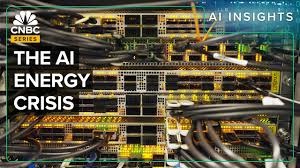
Introduction:
This article discusses the rapidly increasing power demands of data centers, particularly due to the rise of generative AI technologies like ChatGPT and Google’s Gemini. It highlights the challenges this surge poses to our existing power infrastructure and explores potential solutions.
The AI Energy Crisis: A Growing Concern
The rapid advancement of artificial intelligence (AI) is poised to create a significant energy crisis. As AI models become more complex and capable, their computational demands soar, driving up the need for electricity. This surge in energy consumption could strain existing power grids and exacerbate environmental concerns.
Key Drivers of the AI Energy Crisis:
- Data Center Expansion: The training and operation of AI models require vast amounts of data, stored and processed in data centers. These centers are energy-intensive, consuming significant amounts of electricity for cooling, server operations, and other infrastructure.
- Increasing Model Complexity: As AI models become more sophisticated, they require more computational power to function effectively. This translates to higher energy consumption.
- AI-Driven Applications: The widespread adoption of AI in various fields, including healthcare, finance, and transportation, will further increase the demand for AI-powered systems, and consequently, energy.
Potential Consequences of the AI Energy Crisis:
- Energy Shortages: The increased demand for electricity could lead to energy shortages, particularly during peak usage times.
- Environmental Impacts: The reliance on fossil fuels to generate electricity for AI can contribute to greenhouse gas emissions and climate change.
- Economic Disruption: Energy shortages and increased costs can have negative impacts on businesses and consumers.
Video from CNBC:
Related Sections:
Scale of Power Consumption
- Data centers could reach 16% of total US power consumption by 2030
- One ChatGPT query uses nearly 10 times more energy than a typical Google search
- AI image generation can use as much power as charging a smartphone
Infrastructure Challenges
- Aging power grid struggling to handle increased load
- Need for grid hardening and expansion of transmission lines
- Potential for blackouts during peak demand periods
Water Usage
- AI projected to withdraw more water annually by 2027 than 4 times all of Denmark
- Training GPT-3 can evaporate 700,000 liters of clean water
- Water scarcity causing conflicts in some regions (e.g., Chile, Uruguay)
Solutions and Innovations
- Building data centers in areas with abundant power sources
- On-site power generation (e.g., natural gas, solar, nuclear)
- Improving cooling efficiency (e.g., air cooling, liquid cooling)
- Developing more energy-efficient processors (e.g., ARM-based chips)
- On-device AI processing to reduce cloud computing needs
Impact and Opportunities in Southeast Asia, Especially Malaysia, in the Next 5 Years
Southeast Asia, including Malaysia, is poised for significant growth and development in the next 5 years. Several key factors are driving this momentum:
Economic Growth and Development
- Rising GDP: The region is experiencing steady economic growth, driven by factors such as increasing consumer spending, infrastructure development, and industrialization.
- Urbanization: Rapid urbanization is creating new opportunities for businesses in sectors like real estate, retail, and services.
- E-commerce Boom: The growth of e-commerce is transforming the retail landscape and creating new business opportunities.
Technological Advancements
- Digital Transformation: Southeast Asia is embracing digital technologies, leading to advancements in areas such as fintech, e-government, and smart cities.
- AI and Automation: The adoption of AI and automation technologies is expected to drive efficiency and productivity gains across various industries.
Demographic Trends
- Young Population: The region has a large and young population, which represents a significant source of talent and consumer market.
- Rising Middle Class: The growth of the middle class is creating new opportunities for businesses targeting this demographic.
Key Opportunities in Malaysia
- Manufacturing and Industrialization: Malaysia’s strong manufacturing base, coupled with government initiatives to promote industrialization, presents opportunities for foreign investors.
- Palm Oil Industry: Despite facing challenges related to sustainability, the palm oil industry remains a significant contributor to Malaysia’s economy.
- Tourism: Malaysia’s diverse cultural heritage and natural beauty make it a popular tourist destination, offering opportunities for the hospitality and tourism sectors.
- Technology and Innovation: The Malaysian government is actively promoting technology and innovation, creating opportunities for startups and tech companies.
Potential Challenges
- Infrastructure Development: While significant progress has been made, infrastructure development remains a challenge in some areas, particularly in rural regions.
- Political Stability: Ensuring political stability is crucial for sustained economic growth and development.
- Climate Change: The region is vulnerable to the impacts of climate change, such as extreme weather events and rising sea levels.
Overall, Southeast Asia, including Malaysia, offers a promising outlook for the next 5 years. The region’s economic growth, technological advancements, and demographic trends present significant opportunities for businesses and investors. However, addressing challenges such as infrastructure development, political stability, and climate change will be essential for realizing this potential.
Conclusion and Key Takeaways:
- The power demands of generative AI are growing exponentially, putting strain on existing infrastructure.
- Both power generation and efficient distribution are crucial challenges to address.
- Water usage for cooling is a significant concern, especially in water-scarce regions.
- Innovations in chip design, cooling technologies, and on-site power generation offer potential solutions.
- The industry is racing to build more data centers, but supply constraints may limit AI growth in the short term.
Related References:
- Environmental reports from Google and Microsoft on emissions related to data centers
- Data center emissions probably 662% higher than big tech claims. Can it keep up the ruse?
- Reports on data center growth and power consumption projections
- Information on ARM-based processors and their energy efficiency
- Studies on water usage in AI training and data center cooling


